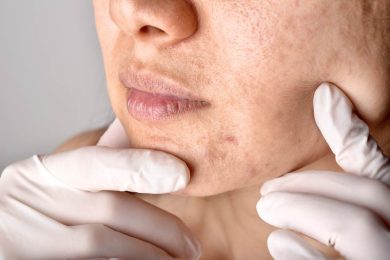What are Nasal Obstructions?
Nasal obstructions are blockages of the nasal cavity that impede airflow in and out of the nose. Either one or both nostrils may be affected. Most nasal obstructions are temporary, caused by colds, allergies, sinus infections, or medications, while others require medical intervention.

What are Types of Nasal Obstruction?
There are several different types of nasal obstruction. These include:
- Deviated nasal septum The nasal septum is the wall-like structure that divides the left and right nostrils. A deviated septum refers to one that is crooked. This is hardly rare; it is estimated that 80 percent of people have septal deviations to some degree. Symptoms include difficulty breathing through the nose (especially one nostril) and a runny nose.
- Inferior turbinate hypertrophy The nasal cavity contains bony structures called turbinates. These are susceptible to irritation from allergies and dust, which cause swelling and breathing difficulties.
- Nasal valve collapse The nasal valve is the narrowest part of the nasal airway and is located between the nasal cartilage within the skin and the inferior turbinate. This is a very common and under-recognized cause of nasal obstruction. If Breathe Right strips provide relief, the nasal valve may be a major cause of nasal obstruction.
- Nasal polyps These are benign growths that occur on the mucosal lining of the nasal passages. They are typically small and noncancerous; however, nasal polyps can still cause obstructions of the sinuses, leading to congestion, breathing problems, and sinus infections.
- Foreign objects in the nose Most cases of foreign objects in the nose occur in toddlers and children. Common objects include food material, tissue paper, beads, toys, and rocks.
- Oversized adenoids The adenoids are soft tissue, similar to the tonsils, located behind the nose and roof of mouth. They are part of the immune system and aid in fighting off infection. They can become infected and enlarged. This can block airflow through the nose.
- Swelling of the nasal lining due to allergies Allergies are the result of the immune system’s response to substances in the environment. When an allergen is encountered, antibodies trigger the release of multiple chemicals including histamines. The release of these inflammatory chemicals and histamines result in the telltale symptoms of allergies, including swelling of the nasal lining.
- Choanal atresia This is a congenital defect in which excess tissue in the nasal airway causes a partial or full blockage, resulting in difficulty breathing.
How is Nasal Obstruction Treated?
The team at Texas ENT & Allergy will carefully examine your nose using a lighted scope and may use a CT scan in order to diagnose your nasal obstruction. The first step in treating nasal obstructions is getting the symptoms under control. Medications or nasal steroid sprays are often helpful in reducing inflammation of the nose and turbinates and providing short-term relief. Allergy testing may also be helpful.
An effective long-term solution may require surgery, particularly if the issue involves a deviated septum, nasal valve collapse, turbinates, or nasal polyps. While traditionally many of the procedures have been performed in the operating room under general anesthesia, newer techniques may allow in-office treatment without general anesthesia.
What is a Deviated Septum?
A deviated septum is a medical condition in which the nasal septum (the bone and cartilage that divide the nostrils) is displaced to one side. This can cause problems with breathing and may lead to other respiratory infections.
What Causes a Deviated Septum?
What Are the Symptoms of a Deviated Septum?
The perfect nasal septum divides the left and right nostrils evenly, but this is pretty rare; it’s estimated that about 80 percent of the population has a septum that is off-center to some extent. Usually, the deviation is slight and goes unnoticed; only the worst cases produce symptoms that affect breathing.
Symptoms of deviated septum can include nasal congestion (often limited to one side of the nose), frequent nosebleeds and sinus infections, facial pain and pressure, headaches, postnasal drip, and noisy breathing or snoring during sleep.
How Is a Deviated Septum Treated?
If the deviated septum isn’t too severe, symptoms may respond to treatment with medications. Antihistamines, decongestants, and nasal steroid sprays can reduce congestion and inflammation in some patients.
When medicines are ineffective, a surgical procedure known as a septoplasty may be necessary to reposition a crooked septum and improve breathing. This involves removing excess bone or cartilage in order to create a larger breathing space, and is typically performed in an outpatient setting, using local or general anesthesia.
In order to prevent a deviated septum, protect your nose from injury whenever possible. Wear a helmet or facial protection when playing sports and never ride in a motor vehicle without wearing a seatbelt.
What are Turbinate Procedures?
Turbinate procedures are surgeries that aim to improve airflow in people with chronic nasal obstruction. The goal of the surgery is to reduce the size of the turbinates (small, bony structures inside of your nose) by removing excess tissue.
Turbinate procedures are typically performed in an operating room under general anesthesia. Sometimes this procedure is performed in conjunction with other procedures to improve nasal breathing (ie: sinus surgery, nasal endoscopy, nasal cautery, or septoplasty for deviated septum).
Turbinate reduction is usually recommended if nonsurgical treatments don’t solve symptoms of chronic nasal obstruction.
How Do I Know If I Need Turbinate Reduction Surgery?
Turbinate reduction surgery is usually only necessary when other treatments haven’t been successful in alleviating symptoms. If you’re struggling with congestion, post-nasal drip, sleep apnea, or other breathing disorders, your healthcare provider may recommend turbinate reduction surgery.
To confirm your diagnosis and check if turbinate reduction surgery is right for you, your ENT doctor will likely perform a physical examination and use nasal endoscopy to examine the inside of your nose.
If you and your ENT doctor decide that turbinate reduction surgery is the best course of action, don’t worry – the procedure is relatively quick and straightforward. In most cases, patients see a significant improvement in their symptoms after surgery.
Turbinate reduction surgery is a safe, outpatient procedure that can improve breathing, reduce snoring, and treat severe nasal allergies. Talk to your doctor about any concerns or questions you may have about the procedure.
Turbinate Reduction Surgical Procedures
Turbinate Reduction Surgical Procedures
A number of surgical procedures are effective in reducing the size of the inferior turbinate, clearing up the airway to eliminate any associated breathing or sinus problems. These include the following:
- Turbinate Resection: This procedure involves removing part of the inferior turbinate while widening the nasal airway. Submucous resection aims to preserve the mucosa of the turbinate in order to reduce side effects.
- Radiofrequency: A probe delivers heat generated from high frequency alternating current to reduce the size of the turbinate.
What is LATERA?
LATERA is a novel nasal implant that may reduce nasal airway obstruction symptoms in patients with nasal valve collapse by supporting the upper and lower cartilage inside the wall of your nose.
A small cannula, or tube, is inserted just inside the nostril. When the cannula tip reaches its target, a clear, thin absorbable implant is placed in a supporting position. The cannula is then removed. The implant provides the patient with ongoing cartilage support, preventing nasal valve collapse and delivering relief from nasal obstruction symptoms.
Who is a Good Candidate for LATERA?
If you find that your breathing improves dramatically when using breathing strips during athletic training or sleeping, you may be a good candidate for LATERA implants. These implants can be placed in the operating room during a septoplasty procedure, or in the office as an isolated procedure.
LATERA is a safe and effective treatment option for those with mild to moderate obstructive sleep apnea. It is also an option for people who cannot tolerate CPAP therapy.
What Are The Risks of LATERA?
Like any procedure, LATERA comes with risks. Patients may experience temporary symptoms such as mild bruising and inflammation, awareness of the implant, and mild pain or irritation. Other risks include discomfort, infection, reaction to material, and need for the device to be removed.
Patients experience no long-term adverse cosmetic changes with the LATERA implant.
What Are The Benefits of LATERA?
LATERA is a highly successful treatment for improving breathing. Almost all patients see a significant improvement in their condition within 4-6 weeks of starting treatment. Often, patients notice an improvement in their breathing within just one week.
LATERA is a minimally invasive procedure that is quick and easy to perform. There is no need for general anesthesia or sedation, and the procedure can be done in an outpatient setting. Recovery time is usually very short, with most patients able to return to their normal activities the next day.
If you are looking for a safe and effective way to improve your breathing, LATERA may be the right option for you.





















